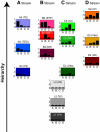Organization of the macaque extrastriate visual cortex re-examined using the principle of spatial continuity of function
- PMID: 21068269
- PMCID: PMC3023372
- DOI: 10.1152/jn.00795.2010
Organization of the macaque extrastriate visual cortex re-examined using the principle of spatial continuity of function
Abstract
How is the macaque monkey extrastriate cortex organized? Is vision divisible into separate tasks, such as object recognition and spatial processing, each emphasized in a different anatomical stream? If so, how many streams exist? What are the hierarchical relationships among areas? The present study approached the organization of the extrastriate cortex in a novel manner. A principled relationship exists between cortical function and cortical topography. Similar functions tend to be located near each other, within the constraints of mapping a highly dimensional space of functions onto the two-dimensional space of the cortex. We used this principle to re-examine the functional organization of the extrastriate cortex given current knowledge about its topographic organization. The goal of the study was to obtain a model of the functional relationships among the visual areas, including the number of functional streams into which they are grouped, the pattern of informational overlap among the streams, and the hierarchical relationships among areas. To test each functional description, we mapped it to a model cortex according to the principle of optimal continuity and assessed whether it accurately reconstructed a version of the extrastriate topography. Of the models tested, the one that best reconstructed the topography included four functional streams rather than two, six levels of hierarchy per stream, and a specific pattern of informational overlap among streams and areas. A specific mixture of functions was predicted for each visual area. This description matched findings in the physiological literature, and provided predictions of functional relationships that have yet to be tested physiologically.
Figures








References
Publication types
MeSH terms
Grants and funding
LinkOut - more resources
Full Text Sources
Molecular Biology Databases

